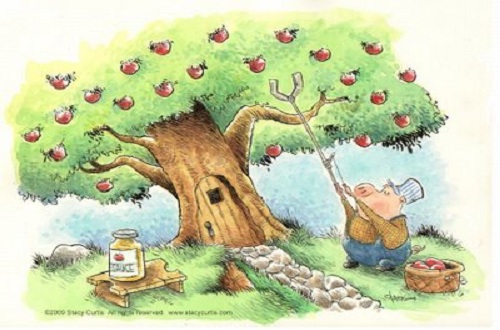Fun Fall Activities for Speech Therapy
For many people, autumn holds the promise of beautiful, breath-taking foliage and fun activities like apple picking. If you love this time of year, you’re probably already stocking up on hot chocolate and visiting your local farmer’s market for bagfuls of colorful pumpkins and acorn squash. (Or, if you’re like me, you’re stocking up on heavy-duty hand lotions to combat dry, lizard-like winter skin.) But if you’re a speech-language pathologist (SLP) or a parent of a speech disordered child, you’re also probably looking for ways to incorporate the season into speech therapy lessons. There are lots of fun activities to do in the fall. With a little tweaking, you can customize your family outings into engaging speech therapy activities. Plus, you’re more likely to keep your child’s attention with hands-on activities than with flashcards.
Apple Picking
Apple picking is a classic fall activity. It’s also the perfect time to work on prepositions with your child. Each member of your family should have his own bag or basket. As you walk along the orchard, point out particularly delicious-looking apples to your child using words rather than actual pointing. Say, “That nice red apple is above Jack’s head… Look at that green apple beside the branch.”
The objective of this isn’t to have your child pick out exactly the apple that you had intended (that could get pretty tricky), but rather to see if he picks up on the prepositions you used. If he reaches for an apple on the ground instead of beside the branch, repeat yourself, stressing the word “beside.” Every time your child puts an apple inside his basket, say “Good job, Cory, you put the apple in the basket.” Encourage your child to narrate his actions using prepositions.
No Apple Orchard Nearby?
If you don’t have the good fortune to live near an apple orchard, you can still go “apple picking” inside your home or out in your backyard. Select about half a dozen apples from the supermarket. Play a treasure hunt game with your child. Hide the apples and then give clues using prepositions. For example, say, “Look above the toy shelf… Look inside the cabinet.”
Halloween Costumes
Most kids love Halloween. Get an early start on it by collaborating on Halloween costumes with your child. Use the costumes as an opportunity to role-play. Roleplaying presents a way to work on your child’s sentence structure and narration skills, as well as articulation. During your role-play conversation, try to incorporate specific words with sounds that your child struggles to articulate. After the roleplaying, you could sneak in a little practice with Speech Buddies to encourage proper articulation.
If little Sarah wants to be a princess, you could dress up as a queen. Engage your child in a discussion of the dragon outside the castle walls, and which teddy bear (or other favorite toy) is likely to conquer it. Encourage Sarah to form complete sentences during the conversation, but don’t try to force it. Instead, model proper sentence structure. For example, if she says, “Dragon scary!” you say, “That dragon does look very scary. But he might be a nice dragon if we make friends with him.”
Arts & Crafts
Customize fall arts and crafts activities to your child’s interests. If he loves baking, look for leaf-shaped cookie cutters. If little Jacob loves the outdoors, take him on a nature walk and collect items like leaves, pinecones, etc. Use these fun activities as a speech therapy lesson that works on building vocabulary and using descriptive words. Describe the colors of the sprinkles on the cookies or the brittleness of the falling leaves. Encourage your child to think of his own descriptive words. Afterward, little Jacob could glue his favorite leaves and other items to construction paper to make a colorful fall collage.
Arts and crafts activities are also a good opportunity to work on following and giving directions. For example, direct your child to color a picture of a pumpkin orange, green, and one other color of his choosing. Then, ask him to tell you which colors you should use on your picture.





